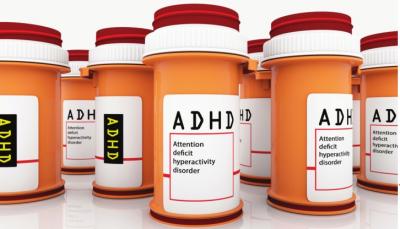ADHD REALITIES

Diagnosis, treatment and parent training essential
Sit down for this one! According to Russell A Barkely, Ph. D., clinical professor of psychiatry at University Medical Center in Richmond, Va., children with ADHD are twice as likely to die in childhood, two and a half times as likely to abuse alcohol or other drugs, five times as likely to attempt suicide when depressed, and
have an average life expectancy 13 years shorter than their peers who do not have the disorder. Approximately 25% will develop clinical depression, and about 50% develop an anxiety disorder. As many as 80% will have additional mental health diagnoses including learning disabilities. Hope those shocking figures got your attention.
What it can look like
Billy won’t sit still in class. He gets out of his seat without permission (as though there are no rules or he has forgotten them), repeatedly talks to other students even though he has been told for the 30th time to be quiet. His mind is off on some journey far from the classroom, where his teacher is trying desperately to share the knowledge he needs to get a job and succeed in life.
Ask him to write an essay, and you’d think you asked for a kidney. Math? Just forget it. Wait a minute, don’t “forget it” because he never learned it. Homework! It is a nightmare for parents. Forty-five minutes of work turns into three hours of begging, threatening, bribing and yelling. Billy can’t seem to do anything right. He breaks in line, can’t wait his turn, breaks the rules and pushes people who get in his way. He threatens people who challenge him. Neighbor moms won’t let their kids play with him because he can be aggressive.
He’s a prolific liar because he has to be creative to get out of trouble all day, every day. Hope he didn’t get a concussion when he fell backward in his chair for the fourth time today ... Oh, and don’t forget that he knocked over a whole glass of milk when grabbing for a chicken finger on his brother’s plate.
He is easily bored and can’t seem to stay on task longer than a few minutes (if that long). He has to be told 20 times to clean his room. When he is finished, you can’t tell it. He often just walks off as though he heard nothing when given a directive. Give him more than one thing to do and nothing gets done.
And yes, he really can focus on something he loves and wants to do. He might be brilliant, but you can’t tell that from his grades. Up to 30 percent of children with ADHD also have learning disabilities. Billy starts to call himself dumb. He gets teased and bullied (sadly, sometimes by adults). It is not uncommon that he becomes depressed (which often looks like anger in children). He feels pain from his teacher’s frustration, his parent’s anger and his peers’ rejection. His claim to fame becomes the “bad, defiant kid.” He hangs with the kids who don’t care or who have stopped caring.
Why? It’s because every kid needs affirmation, and they will find a place to get it. In this group, he is accepted and even esteemed because of his high profile as a trouble-maker. To avoid his unpleasant reality, he starts experimenting with drugs and escapes the world that doesn’t like him. The feeling is mutual!
 Billy
finally gets attention when he shows up at the hospital because he is
thinking about or actually harming himself or others.
Billy
finally gets attention when he shows up at the hospital because he is
thinking about or actually harming himself or others.
The
law might get involved and, worst case scenario, he ends up doing time.
This is by no means the life story of all children with ADHD, but it is
not that uncommon. If diagnosed, treated, understood and supported,
Billy could turn out to be class president, CEO of a Fortune 500
company, or just an ordinary, law-abiding, tax-paying citizen, a great
neighbor and friend.
The Diagnosis
The first diagnoses are informal, given by parents, teachers and peers. They’re not clinical terms; they are just labels like rebellious, stupid, defiant, careless, extremely forgetful, lazy, disrespectful, dishonest, disruptive, irritating, frustration, hard-headed, angry and aggressive. He’s the dreaded “problem child” who won’t do what parents tell him.
He’s
the “bad kid” in a class of 30, where some dedicated teacher is trying
to make learning as interesting and painless as possible. People think,
“His parents must never discipline him at home or he would know how to
act.” On top of everything else, the last thing the over-extended
teacher needs is a dreaded “plan” that makes an already tough job
virtually impossible. (There are effective instruments for diagnosing
ADHD; however, it is best to have a psychologist perform testing for
ADHD and learning disabilities. The report will likely contain
recommended interventions for parents and teachers.)
The Why
Challenging experiences of a person with ADHD is associated with an underperforming frontal lobe. Imaging techniques show less activity in that area of the brain when compared to persons who do not have ADHD. Big deal? Yes, it is. In broad terms that is where decisions are made, alternative behaviors are considered, risks and consequences are considered, emotions are managed, impulsive or inappropriate behaviors are inhibited, tasks are initiated and methodically carried out, and we “remember to remember” routine activities. It’s not working at its optimal level.
Counterintuitively, a doctor prescribes a stimulant to a child (or adult) who is already bouncing off the walls and wow. They
calm down and focus. Could it be that the therapeutic drug “speeds up”
activity in the frontal lobe where executive functions take place? The
result is improved control and better judgment.
What Works?
Medication is the most effective and immediate intervention. If your child were diabetic, you’d not think twice about her or him taking medication on a regular basis. But if the brain isn’t functioning correctly, there is a stigma attached to using the medication that can properly treat it. Think about it!
Research shows that about 93% of patients will have positive effects from the appropriate medication. ADHD medications have been subjected to many years of extensive research that supports its general safety and effectiveness. (All drugs have possible side-effects that should be medically monitored.) Stimulants are the most common drug class, and in many cases, highly effective; however, there are other classes of effective drugs for those who do not respond well to stimulants or who experience side-effects.
Unfortunately, the average length of time that patients take medication is 2.5 years. Parents are not educated about what to do if there are side effects. Often the medication wears off by the time the child gets home and parents get to experience the “rebound” effect that sometimes happens. Behavior ramps up after a relatively controlled day. Emotions sometimes start to boil over for a while. Find the right medication, the right dose (no professional or parent wants a zombie child), the correct administration time or times, and the right delivery system (e.g., extended release, liquid or osmotic pump capsule).

Talk therapy doesn’t work. Therapy that does work is parent training. They learn healthy, effective behavior management skills in the home. They learn to understand and support their child. They learn about proper diagnosis. They learn how to advocate for their child at school including appropriate, effective accommodations (not a “bad” word), and specialized help if their child struggles with learning.
They fall in love with and enjoy that amazing, wonderful, often brilliant child who previously “gave them fits.” They learn how to provide “real-time” social skills training.
They do get talk therapy for their children if there are co-occurring problems like anxiety and depression. They learn to take along “busy” activities when they eat out so everyone in the restaurant doesn’t think they are bad parents. They learn simple things like breaking tasks into smaller, singular assignments instead of strings of instructions. They learn to cover up most of the problems on a math homework sheet so the child doesn’t get overwhelmed by the sight of the “whole” assignment. They learn that teachers can have a special signal they can use to redirect the wandering mind and that there are specific classroom techniques that improve performance. They learn that some children actually focus better with a fidget toy or listening to music while doing school work.
While I am not the person to elaborate on the topic, studies show adverse, permanent changes in the brains of children who are not treated early and effectively.
Like one 6-year-old patient exclaimed, “My brain makes me do it!” He was right. But there is help.
Jonathan Wiggins, M.S., LPC, partial hospitalization program counselor at Brentwood Hospital
